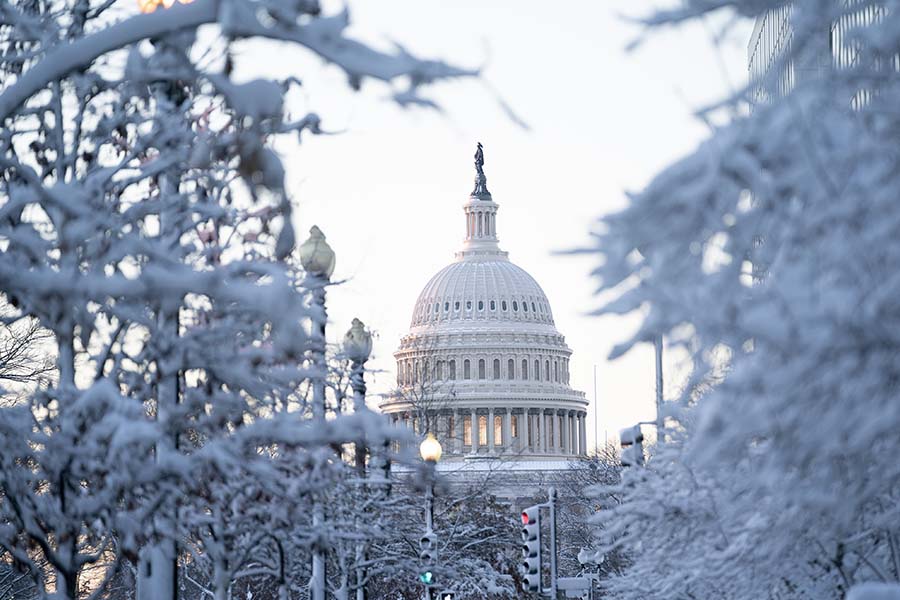Washington: What to Watch Now

Key takeaways
- Trump interviewed a new candidate to succeed Federal Reserve Chair Jerome Powell after his term ends in May, upending speculation he had already settled on a choice.
- The Fed underscored its independence by quietly confirming 11 regional bank presidents to five-year terms.
- As Congress wraps up for 2025, all eyes are on whether lawmakers will extend Affordable Care Act subsidies—the issue at the heart of the 43-day government shutdown earlier this year.
A couple of weeks ago, there were multiple reports that President Donald Trump had settled on Kevin Hassett, the director of the National Economic Council, as his nominee to succeed Jerome Powell as Federal Reserve chair when Powell's term ends in May. Not so fast. Last week, Trump interviewed former Fed Governor Kevin Warsh and apparently came away impressed. In an interview with The Wall Street Journal on December 12th, Trump said Warsh was at or near the top of the list. "I think the two Kevins are great," Trump said.
As he has several times, Trump said that he had made up his mind about who he would nominate and then said he had not made a final decision. Reuters reported on December 14th that there was "pushback by people who have the ear" of the president about Hassett. The president has always liked having speculation about who he will pick for big appointments in the headlines and the possible pivot away from Hassett and toward Warsh certainly does that. The president is not expected to announce a decision until early next year.
Meanwhile, Fed Governor Stephen Miran, who was confirmed by the Senate in September to finish a term that expires in January, told CNBC today that he expects to remain at the Fed past the end of his term until a successor is confirmed by the Senate.
Fed underscores its independence
In a hugely significant development for Fed independence, the board of governors voted to reappoint 11 of the 12 regional Fed bank presidents to new five-year terms. (The 12th, Atlanta Fed President Raphael Bostic, announced he will retire in February and a search is underway for his successor.) The vote was not expected until early 2026, and there had been some speculation that the president was pushing Fed governors to reject some or all of the regional bank presidents so that the White House might have a hand in picking new leaders who would be more aligned with the president's views on monetary policy. That didn't happen, and the unanimous vote indicates it was likely never much of a threat. But Fed watchers are cheering the development as a sign that the Fed's independence won't be compromised easily.
Fed cuts rates again
As expected, the Federal Open Markets Committee (FOMC) lowered the federal funds rate by 25 basis points, the third consecutive rate cut in 2025. There were three dissents—Miran dissented for the third straight meeting, preferring a half-point rate cut, while Kansas City Fed President Jeffrey Schmid and Chicago Fed President Austan Goolsbee dissented in favor of no rate cut at all. Notably, in the "dot plot" released after the meeting, which shows where each of the seven members of the Fed Board and the 12 regional bank presidents think rates are headed, there were four more "silent dissents." A silent dissent happens when a regional bank president who is not a voting member this year indicates that he or she would not have supported the decision if they had a vote. In this case, four regional presidents signaled that they would have preferred no rate cut. It's another sign of the deep divisions at the Fed as it struggles with challenging economic conditions.
Health care in the spotlight
Congress will wrap up its work for the year on December 19th, and it appears all but certain that there will not be a resolution to the expiring health-insurance subsidies. The subsidies, which were at the heart of the 43-day government shutdown earlier this fall, help about 22 million Americans purchase health insurance through the Affordable Care Act but are set to expire at the end of the year, increasing premiums for millions.
The Senate recently rejected dueling proposals on health care, failing to get the necessary 60-vote supermajority on either a Democrat proposal to extend the subsidies for three years or a Republican alternative that would have given individuals money in a Health Savings Account to pay for insurance. This week, the House will vote on a package of Republican health-care proposals, but it won't include any provision to extend the expiring subsidies. Lawmakers may revisit the issue in early 2026 and could pass changes retroactively if a compromise is reached. The expiration of the subsidies and the resulting increase in health-care costs are expected to be key issues in next year's midterm elections.
Supreme Court may be close to tariffs decision
There is speculation in Washington that the Supreme Court could issue by the end of the week a ruling on whether the bulk of Trump's tariffs are legal. Justices seemed skeptical in oral arguments on November 5th that the president's use of an emergency authority to impose the so-called "reciprocal" tariffs was proper. If they are struck down, it could trigger a complicated process of refunding more than $100 billion in tariffs paid to date. It is not at all certain that a decision will be handed down this week. If not, the issue would remain unresolved until sometime in the first quarter of 2026.
Indiana rejects redistricting effort
In the frenzy among states to redraw their congressional districts in advance of the 2026 midterms, Indiana turned out to be something of an outlier. Last week, state senators rejected a plan that would have redrawn that state's map in a way that could have led to Republicans winning two additional seats, potentially turning a 7-2 Republican majority of House seats into a 9-0 majority. It's the latest development in a story that has seen 16 states move forward with redistricting efforts. It started with Texas, where the legislature drew a new map that could lead to Republicans winning as many as five additional seats in the House, only to see California pass a ballot initiative that could result in Democrats gaining as many as five new seats. They were joined by Missouri, North Carolina, Ohio, and Utah, which have all approved new maps for 2026. Florida, Kentucky, Illinois, Maryland and Virginia are all at various stages of considering new maps of their own. Most of these states are facing or will face litigation over the maps.
House passes INVEST Act
The House of Representatives last week passed the Incentivizing New Ventures and Economic Strength Through Capital Formation (INVEST) Act, including e-delivery legislation. The legislation, which packaged together 22 financial services related bills, was approved by the House on a 302-123 vote, with 87 Democrats joining all Republicans in support. The legislation includes e-delivery legislation, which would allow investment companies to send regulatory documents to investors electronically by default. Investors could opt out at any time to continue receiving paper documents. Other notable provisions in the bill include allowing 403(b) plans to invest in collective investment trusts (CITs), as 401(k) plans can do today; expanding the accredited investor definition; barring the SEC from limiting closed-end funds from investing in private funds; and launching a task force on older investors at the SEC. The bill now moves to the Senate where it may receive consideration in 2026.
For more commentary on news and policies from Washington that impact investors, listen to the WashingtonWise podcast.
